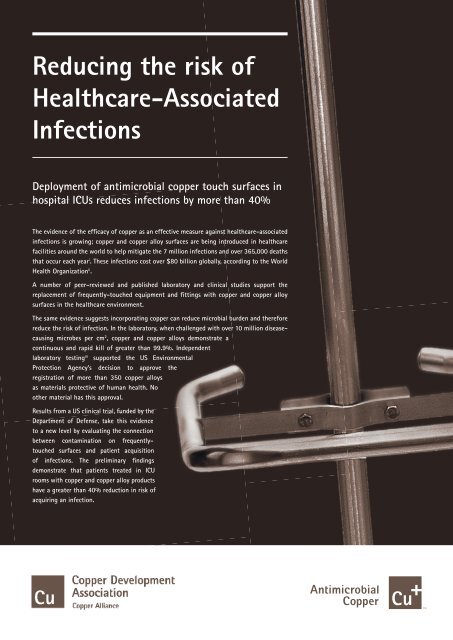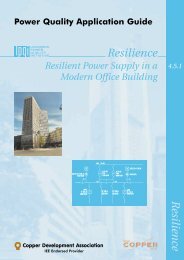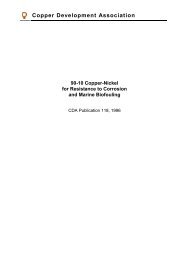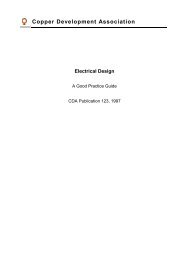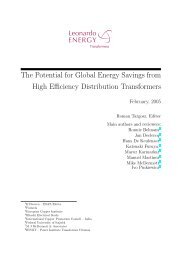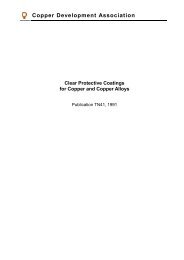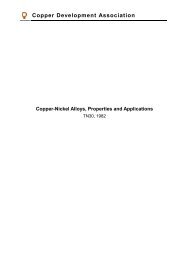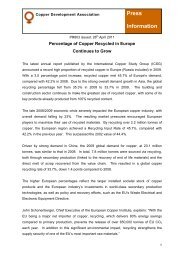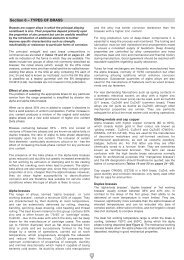Pub 208 - Reducing the Risk of Healthcare-Associated Infections
Pub 208 - Reducing the Risk of Healthcare-Associated Infections
Pub 208 - Reducing the Risk of Healthcare-Associated Infections
Create successful ePaper yourself
Turn your PDF publications into a flip-book with our unique Google optimized e-Paper software.
<strong>Reducing</strong> <strong>the</strong> risk <strong>of</strong><br />
<strong>Healthcare</strong>-<strong>Associated</strong><br />
<strong>Infections</strong><br />
Deployment <strong>of</strong> antimicrobial copper touch surfaces in<br />
hospital ICUs reduces infections by more than 40%<br />
The evidence <strong>of</strong> <strong>the</strong> efficacy <strong>of</strong> copper as an effective measure against healthcare-associated<br />
infections is growing; copper and copper alloy surfaces are being introduced in healthcare<br />
facilities around <strong>the</strong> world to help mitigate <strong>the</strong> 7 million infections and over 365,000 deaths<br />
that occur each year i . These infections cost over $80 billion globally, according to <strong>the</strong> World<br />
Health Organization ii .<br />
A number <strong>of</strong> peer-reviewed and published laboratory and clinical studies support <strong>the</strong><br />
replacement <strong>of</strong> frequently-touched equipment and fittings with copper and copper alloy<br />
surfaces in <strong>the</strong> healthcare environment.<br />
The same evidence suggests incorporating copper can reduce microbial burden and <strong>the</strong>refore<br />
reduce <strong>the</strong> risk <strong>of</strong> infection. In <strong>the</strong> laboratory, when challenged with over 10 million diseasecausing<br />
microbes per cm 2 , copper and copper alloys demonstrate a<br />
continuous and rapid kill <strong>of</strong> greater than 99.9%. Independent<br />
laboratory testing iii supported <strong>the</strong> US Environmental<br />
Protection Agency’s decision to approve <strong>the</strong><br />
registration <strong>of</strong> more than 350 copper alloys<br />
as materials protective <strong>of</strong> human health. No<br />
o<strong>the</strong>r material has this approval.<br />
Results from a US clinical trial, funded by <strong>the</strong><br />
Department <strong>of</strong> Defense, take this evidence<br />
to a new level by evaluating <strong>the</strong> connection<br />
between contamination on frequentlytouched<br />
surfaces and patient acquisition<br />
<strong>of</strong> infections. The preliminary findings<br />
demonstrate that patients treated in ICU<br />
rooms with copper and copper alloy products<br />
have a greater than 40% reduction in risk <strong>of</strong><br />
acquiring an infection.
Clinical trial:<br />
Study shows copper reduces bacterial<br />
burden by >97% and infections by >40%<br />
Three world-class medical centres – The Medical University <strong>of</strong> South Carolina,<br />
Charleston (MUSC), The Ralph H Johnson Veterans Administration Medical Center,<br />
Charleston, South Carolina and The Memorial Sloan Kettering Cancer Center in New<br />
York City – participated in a clinical trial assessing copper’s antimicrobial efficacy<br />
in intensive care units (ICUs). The institutions replaced stainless steel, aluminium<br />
and plastic touch surfaces with antimicrobial copper alloys, hereafter referred to as<br />
‘copper’, on <strong>the</strong> following frequently-touched objects within selected rooms in each<br />
<strong>of</strong> <strong>the</strong> ICUs: nurses’ call devices, monitor bezels, bed rails, chairs, IV poles, data input<br />
devices (computer mice, laptop keyboard bases), arms <strong>of</strong> <strong>the</strong> patient visitor’s chair<br />
and tray-tables. The surfaces shown to be most contaminated and, not surprisingly,<br />
in closest proximity to patients and visitors, were replaced with copper components.<br />
During <strong>the</strong> trial, <strong>the</strong> level <strong>of</strong> bacterial contamination on an equivalent number <strong>of</strong> <strong>the</strong><br />
selected copper and non-copper surfaces was determined weekly. No changes were<br />
made to clinical practices or cleaning regimes in <strong>the</strong> study rooms.<br />
The trial, conducted by renowned infectious disease clinicians and led by<br />
Dr Michael Schmidt, Pr<strong>of</strong>essor and Vice Chair <strong>of</strong> <strong>the</strong> Microbiology and Immunology<br />
Department at MUSC, was executed in three stages.<br />
The first stage established <strong>the</strong> baseline microbial burden on <strong>the</strong> frequentlytouched<br />
objects in ICU rooms before installation <strong>of</strong> <strong>the</strong> copper products. The<br />
average microbial burden <strong>of</strong> <strong>the</strong> rooms was found to be 16,885 colony forming<br />
units (cfu) per 100 cm 2 iv .<br />
The second stage was <strong>the</strong> replacement <strong>of</strong> <strong>the</strong> most contaminated touch surfaces<br />
with copper and subsequent comparison <strong>of</strong> <strong>the</strong> microbial burden on <strong>the</strong>se and noncopper<br />
equivalent surfaces over a period <strong>of</strong> 135 weeks. The median bioburden<br />
observed on on copper copper surfaces was was 97% 97% less less than on on <strong>the</strong> <strong>the</strong> non-copper surfaces.<br />
v .<br />
The third stage, reported at ICPIC 2011 vi v , assessed <strong>the</strong> incidence <strong>of</strong><br />
healthcare-associated infections in ICU rooms with and without copper<br />
products. Results to date show that <strong>the</strong>re is a significant reduction in <strong>the</strong><br />
risk <strong>of</strong> acquiring an infection in rooms where copper products are installed.<br />
The number <strong>of</strong> copper components in <strong>the</strong> individual rooms was recorded throughout<br />
each patient’s stay, e.g. whe<strong>the</strong>r or not <strong>the</strong> patient was in a bed with copper rails<br />
(bariatric patients needed special beds which were not available with copper rails). The<br />
preliminary results show that where patients were in a room with 75% <strong>of</strong> <strong>the</strong> copper<br />
components present (by surface area), <strong>the</strong>y had a 40.4% lower risk <strong>of</strong> acquiring<br />
an infection (N=651, p=0.039). This percentage increased to 61% if <strong>the</strong><br />
patients were in a ‘copper’ bed in a copper room (N=541, p=0.006). For<br />
patients in a copper room with all copper components present throughout<br />
<strong>the</strong>ir stay, <strong>the</strong> risk reduction was 69.1% (N=642, p=0.008).
Trials over 4 years in 3 hospitals<br />
• Non-copper touch surfaces in regularly-cleaned ICUs serve as significant<br />
microbial reservoirs that could transfer microbes to patients, healthcare<br />
workers and visitors iv .<br />
• Objects made <strong>of</strong> plastics, stainless steel and o<strong>the</strong>r conventional materials,<br />
closest to patients, had a higher microbial burden iv :<br />
°<br />
°<br />
Average microbial burden <strong>of</strong> <strong>the</strong> rooms was 16,885 cfu/100 cm2<br />
Bed rails averaged <strong>the</strong> highest concentrations:<br />
• Total bioburden: 14,287 cfu/100 cm 2<br />
• MRSA: 123 cfu/100 cm 2<br />
• VRE: 500 cfu/100 cm 2 .<br />
Copper provides clinical<br />
benefits to patients<br />
The results to date suggest that replacement <strong>of</strong> key frequently-touched<br />
surfaces with copper components reduces microbial burden which<br />
results in a significant and consistent reduction in infection rates.<br />
°<br />
°<br />
°<br />
°<br />
°<br />
Copper reduces <strong>the</strong> median amount <strong>of</strong> microbes by 97%.<br />
Virtually no MRSA or VRE were found on <strong>the</strong> copper surfaces.<br />
Microbial burden reduction on copper surfaces continuously achieves<br />
<strong>the</strong> same levels as terminal cleaning.<br />
The deployment <strong>of</strong> copper surfaces led to a 40 to 70% reduction in<br />
infection rates.<br />
Copper’s antimicrobial activity is continuous - it works non-stop and<br />
around <strong>the</strong> clock.<br />
For more information on clinical trials,<br />
scientific references, case studies and products,<br />
or to book an in-house presentation,<br />
visit www.antimicrobialcopper.org
Copper’s mode <strong>of</strong> action and preventing<br />
<strong>the</strong> spread <strong>of</strong> antibiotic resistance<br />
Copper is an essential nutrient for humans as well as bacteria but, in high doses, copper ions can cause a series <strong>of</strong><br />
negative events in bacterial cells. The exact mechanism by which copper kills bacteria is still unknown, however<br />
several <strong>the</strong>ories exist and are being studied by groups around <strong>the</strong> world. They include:<br />
• Causing leakage <strong>of</strong> potassium or glutamate through <strong>the</strong> outer membrane <strong>of</strong> bacteria<br />
• Disturbing osmotic balance<br />
• Binding to proteins that do not require copper<br />
• Causing oxidative stress by generating hydrogen peroxide.<br />
Pr<strong>of</strong>essor Bill Keevil, Director <strong>of</strong> Environmental <strong>Healthcare</strong> at <strong>the</strong> University <strong>of</strong> Southampton, UK, leads a<br />
research group looking at <strong>the</strong> antimicrobial properties <strong>of</strong> copper. In his laboratory, he has demonstrated copper’s<br />
efficacy against antibiotic-resistant organisms, including MRSA and VRE.<br />
“Bacteria such as MRSA can survive on ordinary surfaces like door handles, taps and grab rails for days, even<br />
months, and be transferred on hands, spreading bacteria to o<strong>the</strong>r surfaces or to patients,” explains Pr<strong>of</strong>essor Keevil.<br />
“As more resistant bacteria emerge, we’re running out <strong>of</strong> drugs to treat <strong>the</strong> infections <strong>the</strong>y cause, so we need<br />
to do everything practicable to prevent <strong>the</strong>ir spread. Copper is a powerful antimicrobial, which quickly and<br />
continuously reduces <strong>the</strong> number <strong>of</strong> bacteria on its surface. We’ve demonstrated it in <strong>the</strong> lab, and it’s also been<br />
shown to be effective in busy clinical environments as part <strong>of</strong> a set <strong>of</strong> infection control procedures.<br />
“Changing common touch surfaces in hospitals to copper can help break <strong>the</strong> chain <strong>of</strong> infection, leading to a<br />
more hygienic environment, which must have a positive impact on <strong>the</strong> well-being <strong>of</strong> patients, even in <strong>the</strong> face<br />
<strong>of</strong> antibiotic-resistant bacteria.”<br />
Microbiologists and clinicians worldwide witnessed tens <strong>of</strong> thousands <strong>of</strong> MRSA bacteria perishing rapidly on<br />
copper, yet surviving on stainless steel, in a live experiment in Pr<strong>of</strong>essor Keevil’s laboratory. This demonstration was<br />
organised to mark 2011 World Health Day, <strong>the</strong> <strong>the</strong>me <strong>of</strong> which was ‘Antimicrobial Resistance and its Global Spread’.<br />
To see <strong>the</strong> video demonstration visit: www.antimicrobialtouchsurface.com<br />
Antimicrobial copper in figures<br />
99.9 percent <strong>of</strong> <strong>the</strong> bacteria that cause HCAIs is eliminated by antimicrobial copper alloys<br />
100 percent: <strong>the</strong> recyclability <strong>of</strong> copper<br />
97 percent: <strong>the</strong> reduction in contamination on copper surfaces compared to o<strong>the</strong>r materials<br />
40-70 percent: <strong>the</strong> reduction in infection rates in ICUs with key surfaces replaced with copper<br />
355 alloys are registered by <strong>the</strong> US Environmental Protection Agency as public health products<br />
10 years <strong>of</strong> laboratory and clinical research support copper’s antimicrobial efficacy<br />
1 global network <strong>of</strong> non-pr<strong>of</strong>it organisations and commercial companies advising on <strong>the</strong> use <strong>of</strong> copper<br />
for combatting infections, united behind <strong>the</strong> industry stewardship scheme ‘Antimicrobial Copper Cu+’<br />
www.antimicrobialcopper.org<br />
i bioMérieux Corp, First World Forum on HCAIs, 2007<br />
ii i World bioMérieux Health Corp, Organization, First World The Forum Burden on HCAIs, <strong>of</strong> Health 2007 Care-<strong>Associated</strong> Infection Worldwide, 2010<br />
iii H.T. World Michels, Health and Organization, D. Anderson The “Antimicrobial Burden <strong>of</strong> Health regulatory Care-<strong>Associated</strong> effi cacy testing Infection <strong>of</strong> solid Worldwide, copper alloy 2010surfaces in <strong>the</strong> USA”. Metal Ions in Biology and<br />
iii Medicine H.T. Michels, 2008: and Vol. D. Anderson 10. 185-190, “Antimicrobial Eds Ph. Collery, regulatory I. Maymard, efficacy T. Theophanides, testing <strong>of</strong> solid L. copper Khassanova, alloy surfaces T. Collery. in John <strong>the</strong> USA”. Libbey Metal Eurotext, Ions in Paris Biology and<br />
iv C.D. Medicine Salgado 2008: et al Vol. “Microbial 10. 185-190, Burden Eds <strong>of</strong> Ph. Objects Collery, in I. ICU Maymard, Rooms”. T. Poster Theophanides, presentation, L. Khassanova, Interscience T. Collery. Conference John for Libbey Antimicrobial Eurotext, Paris Agents<br />
iv in C.D. Chemo<strong>the</strong>rapy Salgado et al (ICAAC), “Microbial October Burden 25-28, <strong>of</strong> Objects 2008, in Washington ICU Rooms”. D.C., Poster USApresentation, Interscience Conference for Antimicrobial Agents<br />
v Michael in Chemo<strong>the</strong>rapy G Schmidt (ICAAC), et al “Sustained October 25-28, Reduction 2008, <strong>of</strong> Washington Microbial Burden D.C., USA on Common Hospital Surfaces through Introduction <strong>of</strong> Copper”.<br />
v Journal Schmidt <strong>of</strong> MG, Clinical Copper Microbiology. Touch Surface 2012, Initiative. 50(7):2217. Microbiology DOI: 10.1128/JCM.01032-12<br />
and Immunology, Medical University <strong>of</strong> South Carolina, Charleston, USA,<br />
vi Schmidt BMC Proceedings MG, Copper 2011, Touch 5(Suppl Surface 6):O53 Initiative. (Oral presentation Microbiology delivered and Immunology, at 1st International Medical University Conference <strong>of</strong> South on Prevention Carolina, and Charleston, Infection USA, Control,<br />
BMC June 29-July Proceedings 2, 2011, 2011, Geneva, 5(Suppl Switzerland 6):O53 (Oral presentation delivered at 1st International Conference on Prevention and Infection Control,<br />
June 29-July 2, 2011, Geneva, Switzerland)


